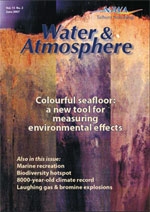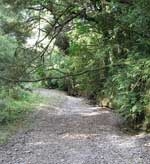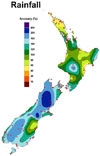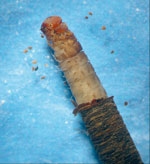PDF of this article (534 KB)






Now you see it, now you don’t. Richard Storey and John Quinn have taken a close look at intermittent streams to learn what happens to the inhabitants when their homes dry up.
Could you survive if your home were flooded for two months each year? An aquatic invertebrate living in an intermittent stream or river faces the same challenge in reverse: its respiratory system, water balance, temperature tolerances, and mode of movement are all adapted for living underwater. So what happens when the stream dries up?
What is an intermittent stream?
Streams that stop flowing for a significant amount of time (weeks or months) during a normal year are classified as intermittent. Roughly speaking, they fall into two types.
- Small streams at the very tops of headwaters can go dry as the stream network contracts during the dry season.
- Larger ‘mid-reach’ streams or rivers may have permanent flow in their headwaters but lose water when they cross an area where the water table sometimes falls below the level of the stream bed.
What can live there?
Many people believe that intermittent streams must have little biological value because they are not always flowing. We wanted to find out exactly what lives in intermittent streams, so we surveyed three small intermittent streams in Hawke’s Bay every month for a year. We found that, overall, these streams had fewer species of invertebrates than streams that flow permanently. But fewer species means less competition, so some invertebrates that are rarely found in permanent streams are more common in intermittent ones. We found two rare species: Nesoperla, a stonefly, and Tarapsyche, a caddisfly.
We also discovered that, as they begin to dry up, intermittent streams go through a ‘pool phase’ when a new set of species, adapted to still water, appears. When you add these species to those in the flowing-water phase, the total species count is much higher. Native fish are also able to survive in intermittent streams, moving in and out of stream reaches as they flood and dry (see ‘Like a fish out of water’, W&A 14(1): 18–19).
How do invertebrates survive the dry period?
This question is interesting scientifically, and the answers will also help us figure out how to protect the biological communities in intermittent streams. To answer it, during the dry season we took samples of the dry stream-bed sediments. We returned these to the lab, put them in water, and then sampled them again at intervals of 3 hours, and 3, 8, 15, and 21 days to see whether any aquatic invertebrates had become active. Out of the 54 taxa (groups) of aquatic invertebrates we had found when the stream was flowing, 44 had remained alive in the stream-bed sediments after the stream dried up. Different invertebrate groups survived in different forms. Most of the mayflies, caddisflies, stoneflies, and chironomids (midges) appeared to survive as eggs that hatched when water was added. Most of the Diptera (true flies) survived as pupae with a resistant skin. Invertebrates with shells, such as the snails and ostracods (tiny crustaceans) probably survived easily by closing their shells tightly.
We also investigated whether the invertebrates migrate to wet or moist areas where it is easier to survive the drought. We dug deep into the stream bed, and discovered a number of aquatic insects surviving below the water table. Finally, we placed large nets over the dry streams and found that some aquatic insects were able to survive a short dry season in their adult phase, which is fully terrestrial.
The most effective dry season refuge for aquatic invertebrates, however, is nearby sections of stream that remain permanently flowing. If a permanent section exists upstream of an intermittent section, invertebrates can easily recolonise the intermittent section every year by drifting in from upstream as soon as water returns there. This means that intermittent streams with permanently flowing headwaters have a very different species composition to those without.
What are the threats to intermittent streams?
Though they face many of the same threats as permanently flowing streams, intermittent streams endure additional problems. Their invertebrate inhabitants may die out when they are cut off from their dry-season refuges. When forest cover around streams is lost, the sediments may become too hot in summer for resting invertebrates to survive, and the habitats below the water table may become clogged with silt. Developments such as dams, that separate an intermittent section of a stream from permanently flowing sections, will also disrupt the invertebrate community.
Intermittent streams have lower species diversity than permanently flowing streams, but they do support viable communities of aquatic invertebrates and may contain some rare species. Invertebrates living in intermittent streams need refuges to survive the dry season, and protecting these refuges is essential to maintaining healthy stream communities.
Do the bugs bug out?
- New Zealand’s intermittent streams provide a challenging habitat where only a few aquatic invertebrates can survive.
- A year-long survey compared biodiversity in intermittent and permanently flowing streams.
- Lab studies investigated how different invertebrate species survive the dry spells.
Are there intermittent streams near you?
In hot, dry countries, the majority of streams are intermittent. In New Zealand, we still don’t know much about their distribution, so one of the aims of our research is to determine how common they are and where they occur.
At present, our best guess is that the larger, mid-reach type occurs mostly in the drier eastern areas, such as Canterbury, Hawke’s Bay, Central Otago, and Tasman District. We think the smaller, headwater-type may occur all over New Zealand.
A difficulty in this research is that streams can only be identified as intermittent after they have been observed for many months. So, if you know of intermittent streams in your area, please tell us!
Contact Richard Storey at [email protected] or 0-7-859 1880.
Further reading
Kelly, D.; Davey, A.; James, G. (2006). ‘Like a fish out of water’: life in a disappearing river. Water & Atmosphere 14(1): 18–19.
Dr Richard Storey has a FRST-funded post-doctoral fellowship and Dr John Quinn is a principal scientist in the River Ecosystems Group; they both work at NIWA in Hamilton. They thank the Hawke’s Bay Regional Council and the Hudson and Macdonald families of Tikokino for help with the field work.
Teachers’ resource for NCEA Achievement Standards or Unit Standards: Biology Level 2 AS90461 See other curriculum connections
